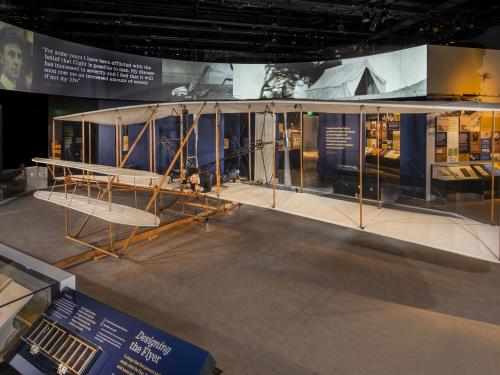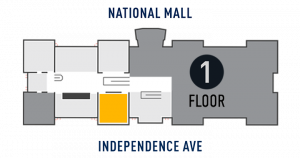
National Air and Space Museum in Washington, DC
On View Exhibition

National Air and Space Museum in Washington, DC
On View Exhibition
The Wright brothers designed and constructed the world's first practical fixed-pitch propeller and developed the aerodynamic theory to calculate its performance during the process of creating their historic 1903 Flyer. Conceptualizing the propeller as a rotating, twisted wing moving in a helical path, the brothers used airfoil data obtained from their wind tunnel to design blades able to convert power from their small engine into thrust.
Believing that "the propeller should in every case be designed to meet the particular conditions of the machine to which it is applied," the Wrights designed their propellers (they used two on the airplane) for one specific performance regime. Using a drawknife and hatchets, they shaped the propellers from two laminated pieces of spruce, covered the tips with linen, and sealed them with aluminum powder suspended in varnish. Overall, these two propellers produced 66 percent efficiency, enough to get off the ground at Kitty Hawk.
This original propeller was used on the 1903 Wright Flyer on December 17, 1903, during its first flight.
This object is on display in Wright Brothers & The Invention of the Aerial Age at the National Air and Space Museum in Washington, DC.

1903
United States of America
PROPULSION-Propellers & Impellers
Wright Brothers, Dayton, Ohio
Type: Two-Blade, Fixed-Pitch, Wood
Diameter: 259.1 cm (102 in.)
Chord: 19.2 cm (7.6 in.)
Engine Application: Four-Cylinder, Horizontal Inline, Water-Cooled, 9 kw (12 hp)
Rotor/Propeller: 259.1 x 19.2 x 8.9cm (102 x 7 9/16 x 3 1/2 in.)
Kiln-dried spruce in two pieces
Silver coating
A19830381000
Gift of Harold & Ivonette Miller and others
National Air and Space Museum
Open Access (CCO)
For more information, visit the Smithsonian’s Terms of Use.